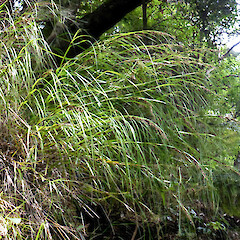Gahnia lacera
Common name
cutty grass
Synonyms
Lampocarya lacera A.Rich.
Family
Cyperaceae
Flora category
Vascular – Native
Endemic taxon
Yes
Endemic genus
No
Endemic family
No
Structural class
Sedges
NVS code
The National Vegetation Survey (NVS) Databank is a physical archive and electronic databank containing records of over 94,000 vegetation survey plots - including data from over 19,000 permanent plots. NVS maintains a standard set of species code abbreviations that correspond to standard scientific plant names from the Ngä Tipu o Aotearoa - New Zealand Plants database.
GAHLAC
Current conservation status
The conservation status of all known New Zealand vascular plant taxa at the rank of species and below were reassessed in 2017 using the New Zealand Threat Classification System (NZTCS) – more information about this can be found on the NZTCS website. This report includes a statistical summary and brief notes on changes since 2012 and replaces all previous NZTCS lists for vascular plants.
Please note, threat classifications are often suggested by authors when publications fall between NZTCS assessment periods – an interim threat classification status has not been assessed by the NZTCS panel.
- Conservation status of New Zealand indigenous vascular plants, 2017 . 2018. Peter J. de Lange, Jeremy R. Rolfe, John W. Barkla, Shannel P. Courtney, Paul D. Champion, Leon R. Perrie, Sarah M. Beadel, Kerry A. Ford, Ilse Breitwieser, Ines Schönberger, Rowan Hindmarsh-Walls, Peter B. Heenan and Kate Ladley. Department of Conservation. Source: NZTCS and licensed by DOC for reuse under the Creative Commons Attribution 4.0 International licence.
2017 | Not Threatened
Previous conservation statuses
2012 | Not Threatened
2009 | Not Threatened
2004 | Not Threatened
Distribution
Endemic. North Island from Te Paki south to about Awakino in the west and East Cape in the East.
Habitat
Coastal to lowland (rarely extending up to 500 m a.s.l. in mountain ranges close to the sea). Colonising a variety of substrates which may be seasonally waterlogged thoughotherwise dry. Usually found in scrub or open forest.
Detailed description
Stout, bambusiform, perennial sedge forming dense, yellowish-green tufts. Rhizome shortly creeping, 5–8 mm diameter, very hard, lignaceous, long persistent when dead. Culms 0.6–2.0 m, 2–4 but up to 6 mm diameter at the base. Leaves numerous, almost all cauline and ≥ culms; lamina up to 380 mm long and 9 mm wide, yellow-green, green or dark green, flat or involute, glabrous, margins scabrid; sheaths all closely appressed to and enclosing base of culm, rugose above, maturing dark brown to almost black, smooth and glossy towards the node. Panicle 20–600 × 30–60 mm, rigid, usually erect, many-flowered, light brown with branchlets 20–160 mm long, usually in dense though more or less distant clusters along the axis of the panicle. Spikelets 1-flowered, 8 mm long, alternate on the branchlets, sessile or shortly stalked. Glumes 4–5; the outer 2–3 light red-brown; inner glumes pale cream, with a red lacerate apex. Stamens 4. Style-branches 3. Nut 3.5–4.5 mm long, slightly < 2 mm diameter, oblong-ellipsoid or oblong-obovoid, lustrous black, with a minute apiculate apex, endocarp obscurely transverse striate within.
Similar taxa
Immediately distinguished from all other Gahnia species and Morelotia affinis (Brong.) Blake by the rhizomatous habit, and stout, bamboo-like culms.
Flowering
July–November
Fruiting
Fruits may be present throughout the year
Life cycle
Florets are wind dispersed (Thorsen et al., 2009).
Propagation technique
Can be difficult to cultivate. The seed is difficult to germinate, and plants resent root disturbance and usually die if transplanted. However, considerable success has been achieved growing plants and/or germinating seed in untreated saw dust. Despite these problems this is an attractive species well worth attempting to grow. Once established it flourishes in a range of conditions but does best in full sun in a well drained or only seasonally wet soil.
Etymology
gahnia: After Gahn
Attribution
Fact Sheet prepared by P.J. de Lange (30 October 2005). Description adapted from Moore and Edgar (1970)
References and further reading
Gardner RO. 1996. Gahnia pauciflora and G. procera and a note on G. lacera. Auckland Botanical Society Journal 51: 7–10.
Moore LB, Edgar E. 1970. Flora of New Zealand, Volume II. Indigenous Tracheophyta: Monocotyledones except Gramineae. Government Printer, Wellington, NZ. 354 p.
Thorsen MJ, Dickinson KJM, Seddon PJ. 2009. Seed dispersal systems in the New Zealand flora. Perspectives in Plant Ecology, Evolution and Systematics 11: 285–309.
NZPCN Fact Sheet citation
Please cite as: de Lange, P.J. (Year at time of access): Gahnia lacera Fact Sheet (content continuously updated). New Zealand Plant Conservation Network. https://www.nzpcn.org.nz/flora/species/gahnia-lacera/ (Date website was queried)












